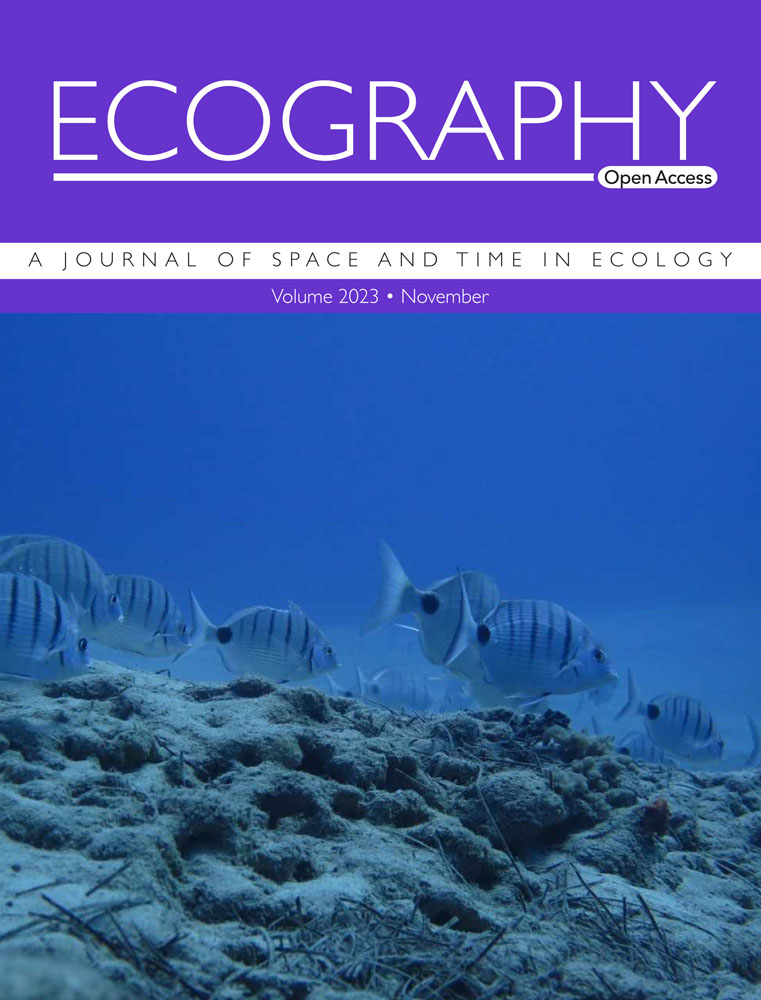Latitudinal patterns and climatic drivers of Laurasian and Gondwanan angiosperm tree distributions in forests of the Americas
IF 5.4
1区 环境科学与生态学
Q1 BIODIVERSITY CONSERVATION
引用次数: 0
Abstract
The biogeographic affinity of a lineage leaves imprint on its niche, and influences its distribution under biotic interchange between landmasses. Since the beginning of the Quaternary, North America (a remnant of Laurasia) and South America (a remnant of Gondwana) have been united, and triggered the Great American Biotic Interchange. Based on existing knowledge, we expect more Laurasian lineages to occur at higher latitudes, in colder or drier areas; and more Gondwanan lineages to reside at lower latitudes, in hotter and wetter areas of the Americas. Moreover, the tropical niche conservatism (TNC) hypothesis states that the tropical flora be most ancient. If so, then both younger Laurasian and Gondwanan lineages would occur in regions at colder and higher latitudes. Here, we examine the latitudinal patterns of species richness and mean family age of Laurasian and Gondwanan angiosperm tree lineages in 422 forest plots distributed across the Americas, and investigate the underlying continent and climatic drivers. We found opposite latitudinal and climatic patterns for species richness of Laurasian and Gondwanan lineages, the former declined towards lower latitudes and hotter climates, whereas the latter declined towards higher latitudes and colder climates. In particular, more pronounced climatic patterns for species richness of Laurasian and Gondwanan lineages were observed in North and South America, respectively. In addition, the mean family age of Laurasian lineages declined towards higher latitudes and colder climates, and for Gondwanan lineages it also decreased towards higher latitudes in South America, hence supporting the TNC hypothesis. We suggest Laurasian and Gondwanan angiosperm tree lineages in forests of the Americas exhibit diverged climate niche preferences, perhaps partly due to diversification of the former in extratropical climates in recent geological times.一个种系的生物地理亲缘关系会在其生态位上留下烙印,并在陆块之间的生物交汇中影响其分布。自第四纪开始,北美洲(劳拉西亚的残余)和南美洲(冈瓦纳的残余)结合在一起,引发了美洲生物大交流。根据现有的知识,我们预计更多的劳拉西亚类群出现在纬度较高、较寒冷或较干燥的地区;而更多的冈瓦纳类群出现在纬度较低、较炎热和较潮湿的美洲地区。此外,热带生态位保守主义(TNC)假说认为热带植物群最为古老。如果是这样的话,那么较年轻的劳拉夏系和冈瓦纳系都会出现在较冷和较高纬度的地区。在这里,我们研究了分布在美洲的 422 块森林地块中的物种丰富度纬度模式以及劳拉西亚和冈瓦纳被子植物树系的平均科龄,并探讨了其背后的大陆和气候驱动因素。我们发现劳拉西亚和冈瓦纳树系物种丰富度的纬度和气候模式截然相反,前者在纬度较低和气候较热的地区减少,而后者在纬度较高和气候较冷的地区减少。特别是在北美洲和南美洲,劳拉夏系和冈瓦纳系的物种丰富度分别出现了更明显的气候模式。此外,劳拉夏系的平均科龄随着纬度的升高和气候的寒冷而降低,而冈瓦纳系的平均科龄也随着南美洲纬度的升高而降低,从而支持了TNC假说。我们认为,美洲森林中的劳拉西亚和贡兹瓦纳被子植物系表现出不同的气候生态位偏好,部分原因可能是前者在近代地质时代的外热带气候中进行了多样化。
本文章由计算机程序翻译,如有差异,请以英文原文为准。
求助全文
约1分钟内获得全文
求助全文
来源期刊

Ecography
环境科学-生态学
CiteScore
11.60
自引率
3.40%
发文量
122
审稿时长
8-16 weeks
期刊介绍:
ECOGRAPHY publishes exciting, novel, and important articles that significantly advance understanding of ecological or biodiversity patterns in space or time. Papers focusing on conservation or restoration are welcomed, provided they are anchored in ecological theory and convey a general message that goes beyond a single case study. We encourage papers that seek advancing the field through the development and testing of theory or methodology, or by proposing new tools for analysis or interpretation of ecological phenomena. Manuscripts are expected to address general principles in ecology, though they may do so using a specific model system if they adequately frame the problem relative to a generalized ecological question or problem.
Purely descriptive papers are considered only if breaking new ground and/or describing patterns seldom explored. Studies focused on a single species or single location are generally discouraged unless they make a significant contribution to advancing general theory or understanding of biodiversity patterns and processes. Manuscripts merely confirming or marginally extending results of previous work are unlikely to be considered in Ecography.
Papers are judged by virtue of their originality, appeal to general interest, and their contribution to new developments in studies of spatial and temporal ecological patterns. There are no biases with regard to taxon, biome, or biogeographical area.
 求助内容:
求助内容: 应助结果提醒方式:
应助结果提醒方式:


